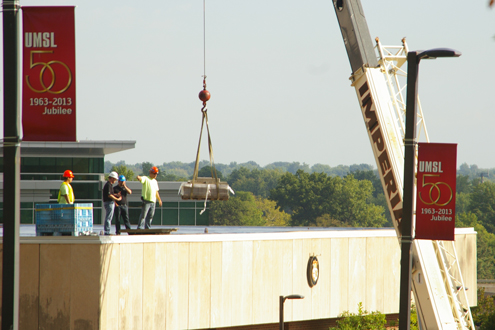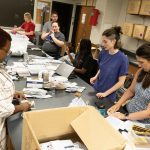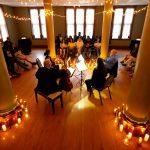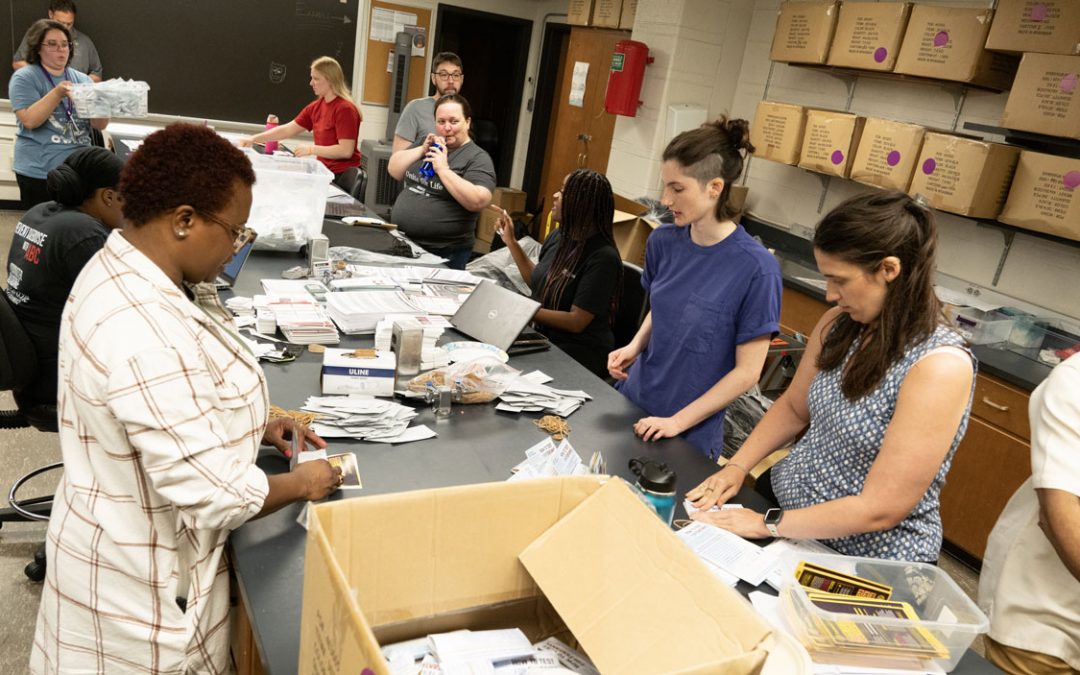
Microgrid Energy employees await a batch of solar panels lifted by crane on Aug. 21 to the roof of the Mark Twain Athletic & Fitness Center at UMSL. The panels were installed through funding from UMSL's campus neighbor, Express Scripts. (Photo by Jim Jordan)
Thanks to Express Scripts, the University of Missouri–St. Louis’ carbon footprint just got smaller.
With funding from the company, UMSL has completed its first solar panel installation to generate electricity. The roof of UMSL’s Mark Twain Athletic & Fitness Center, just across the street from Express Scripts headquarters, features a 25-kilowatt solar photovoltaic system that converts sunlight into electricity.
Energy produced by the system is equivalent to the annual electricity use for four homes. While the energy generated is a small portion of electricity used on campus, the project is part of a university strategy to reduce energy use.
When Express Scripts built its headquarters on the UMSL campus in 2007, the company became the first Fortune 500 company headquartered on a university campus. Express Scripts also collaborates with university faculty and students and looks for ways to share information technology and research expertise.
The most recent collaboration is similar to an arrangement Express Scripts made with the Missouri Botanical Garden in early 2011 to install solar panels on the Garden’s Commerce Bank Education Center.
“You can recapture about half the cost of a solar array in the form of federal tax benefits, but to do that, you need a taxable entity that owns the system,” said Rick Hunter, chief executive officer of Microgrid Energy, the company that installed the panels. “In this case, that taxable entity is Express Scripts.”
Since the Botanical Garden project, Microgrid has used this model to bring solar panels to a number of schools and nonprofit organizations. When UMSL began researching renewable energy, an arrangement with Express Scripts made sense, Hunter said.
With an information kiosk and online monitoring system that shows how much electricity it’s producing, the solar project is as much an educational opportunity as a green initiative. Joe Martinich, professor of logistics and operations management at UMSL, teaches a course about the environmental aspects of business operations. He has incorporated the project into class discussions and is considering additional ways to use the installation for educational purposes.
“I plan to discuss some of the technology involved and hope to use the information kiosk or take the students onto the roof to show them up close what the panels look like and why they are installed the way they are,” Martinich said. “Having panels on campus will make the course material more tangible, and I expect people who teach other environmental courses will use them as teaching tools as well.”
Article courtesy of Express Scripts.














